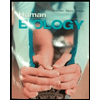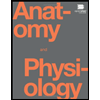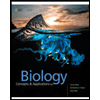
HUMN ANAT&PHYS ALC&MOD MA&P/ET&ACTV LRNG
2nd Edition
ISBN: 9780137374625
Author: AMERMAN
Publisher: PEARSON
expand_more
expand_more
format_list_bulleted
Question
Chapter 5.2, Problem 4QC
Summary Introduction
To review:
The difference between thick and thin skins.
Introduction:
The skin is made up of two major components, the dermisand the epidermis. In certain regions of the body like the palms, the skin is found to be thick, while it is thin on regions such as theabdomen. This difference can be explained on the basis of structure–function core principle.
Expert Solution & Answer
Want to see the full answer?
Check out a sample textbook solution
Students have asked these similar questions
What will control the rate of bioremediation of petroleum? (Choose all correct answers)
The availability of the petroleum
The temperature of the water
The availability of oxygen
The percent of the population that has degraded petroleum in the past
Which of the following would lead to a false negative result in a sandwich ELISA (the lab manual refers to this as a direct ELISA- also known as search for antigen)? Mark all correct answers.
antibody was non-specific and bound to something other than the antigen of interest.
too short of a duration when incubating the reagents in the plate.
If there are multiple strains of the pathogen of interest and the antibody does not recognize one of the strains.
Did not sample the correct bodily fluid/area to detect the antigen
concentration of antigen was too low to detect in the patient sample.
inadequate washing was performed after the enzyme linked antibody was allowed to bind.
substrate was exposed to too much light
reusing a pipette that was used to pipette a positive sample.
S.
+1269 pts
/1500
© Macmillan Learning
0
Resources
Solution
Penalized
Feedback
Try Again
Draw the final product with stereochemistry and lone pairs. The leaving group has been pre-drawn for
your convenience.
+100
+100
: 0:
+
H,C-
:0:
: 0
0 :
+100
+94
possible
✓ +100
K
Attemp
Chapter 5 Solutions
HUMN ANAT&PHYS ALC&MOD MA&P/ET&ACTV LRNG
Ch. 5.1 - 1. What are the major structures of the skin, and...Ch. 5.1 - 2. How does the integument provide protection...Ch. 5.1 - Prob. 3QCCh. 5.1 - What are the other functions of the integument?...Ch. 5.2 - 1. What are the five strata of the epidermis? How...Ch. 5.2 - How does a keratinocyte that begins its life in...Ch. 5.2 - Prob. 3QCCh. 5.2 - Prob. 4QCCh. 5.3 - Which type of tissue makes up the papillary layer...Ch. 5.3 - What are the functions of the dermal papillae?
Ch. 5.3 - 3. Which type of tissue makes up the reticular...Ch. 5.3 - 4. What other structures are located in the...Ch. 5.3 - 5. How does the papillary layer of the dermis...Ch. 5.3 - What causes tension lines and flexure lines? How...Ch. 5.4 - How is melanin produced, and how does it interact...Ch. 5.4 - What are the functions of melanin?Ch. 5.4 - 3. What is carotene, and what color does it give...Ch. 5.4 - Prob. 4QCCh. 5.4 - 5. How can the oxygen content of the blood affect...Ch. 5.4 - 6. What is cyanosis, and what can it tell us...Ch. 5.5 - How do the hair shaft and hair root differ?Ch. 5.5 - How does a hair grow in length?Ch. 5.5 - Prob. 3QCCh. 5.5 - Define the following terms: nail bed, nail plate,...Ch. 5.5 - How does nail growth occur?Ch. 5.5 - Prob. 6QCCh. 5.5 - What are the other three types of sweat glands,...Ch. 5.5 - 8. How do sebaceous glands and sebum differ from...Ch. 5.6 - Prob. 1QCCh. 5.6 - Prob. 2QCCh. 5.6 - What is cancer?Ch. 5.6 - 4. How do the three types of skin cancer differ?
Ch. 5 - Explain why the skin is an organ.Ch. 5 - Which of the following correctly describes the...Ch. 5 - Which of the following is not a function of the...Ch. 5 - 4. Explain what happens to dermal blood vessels...Ch. 5 - Number the strata of thick skin epidermis from...Ch. 5 - Keratinocytes in the superficial strata of the...Ch. 5 - Mark the following statements as true or false. If...Ch. 5 - Which of the following statements is false? a....Ch. 5 - What are the functions of the dermal papillae?Ch. 5 - Epidermal ridges are created by: a. the epidermal...Ch. 5 - 11. Mark the following statements as true or...Ch. 5 - 12. Which of the following is not a function of...Ch. 5 - 13. Fill in the blanks: The portion of the hair...Ch. 5 - Nail growth occurs when: a. cells in the nail...Ch. 5 - Prob. 15CYRCh. 5 - Match each type of gland with its correct...Ch. 5 - How do sweat and sebum differ?Ch. 5 - 18. Which type of burn involves the epidermis and...Ch. 5 - 19. The type of skin tumor that involves the...Ch. 5 - Prob. 1CYUCh. 5 - Prob. 2CYUCh. 5 - The hair and nails are sometimes called accessory...Ch. 5 - 1. You are working in the emergency department...Ch. 5 - 2. After Ramon’s skin came into contact with a...Ch. 5 - 3. Which of the following is not a function of...Ch. 5 - 4. What would happen to the skin if the oil...Ch. 5 - Many antiaging skin creams contain collagen and...Ch. 5 - 6. Would a mild second-degree burn be likely to...
Knowledge Booster
Learn more about
Need a deep-dive on the concept behind this application? Look no further. Learn more about this topic, biology and related others by exploring similar questions and additional content below.Similar questions
- +1269 pts /1500 © Macmillan Learning t/1188d950-dd73-11e0-9572-0800200c9a66/3045511b-267e-4a00-86ca-85dbc62ecb4e/6ac3a0c9-... a □ 出 All Bookmarks Due: Mon, May 26 Resources Solution Penalized Feedback Try Again KX Attempt 3 Draw the final product with stereochemistry and lone pairs. The leaving group has been pre-drawn for your convenience. :0: + нс H,C- :0: : 0:arrow_forwards. +1169 pts /1500 © Macmillan Learning 0 Resources Hint Submit Answer Step 3: This tertiary carbocation intermediate readily undergoes elimination with any weak base to form two possible products. + + H :0: H +94 possible 3a) Draw the minor organic product of elimination. Select Draw Templates More +100 +95 possible # C Major product + Minor product 3b) Draw the major organic product of elimination. Erase Select Draw Templates More C Erasearrow_forwardExplain the Science & Society on (with links and pictures): ---- Question down below Discuss the ethical, medical, and societal implications of using advanced genetic techniques?arrow_forward
- Explain the Disease Mechanism & Impact on (with links and pictures): What causes Leigh Syndrome and why it's so deadly. Which cellular functions, organelles (especially mitochondria), and macromolecules are involved.arrow_forwardExplain the Disease Mechanism & Impact on (with links and pictures): What's going wrong inside the cell and the effects on the human body. Describe metabolism with an emphasis on cellular respiration.arrow_forwardExplain the Disease Mechanism & Impact on (with links and pictures):arrow_forward
- Explain the Science & Society on (with links and pictures): Discuss the ethical, medical, and societal implications of using advanced genetic techniques.arrow_forward↑ LED Tt O Tt e 0 ✓ B > FLORES DIology Second Semester Review 7. Chi Square Analysis: wild dumpy male x ebony wild female F1: All wild wild F2: 142 wild wild males 52 wild ebony males 46 dumpy wild males 17 dumpy ebony males 151 wild wild females 47 wild ebony females 51 dumpy wild females 8 dumpy ebony females What pattern of inheritance is observed for body color? Autosomal recessive Autosomal dominant Sex-linked recessive Sex-linked dominant What are the genotypes of the parents in the P generation? a. XBYdd x XbXbDD b. Bbdd x bbDd c. BBdd x bbDD d. BBX Y x bbXDY How many flies in the F2 generation would you expect to express the dumpy wild phenotype? a. 289.125 b. 97 c. 96.375 d. 293arrow_forward4. This question focuses on entrainment. a. What is entrainment? b. What environmental cues are involved in entrainment, and which one is most influential? c. Why is entrainment necessary? d. Assuming that a flash of darkness is an effective zeitgeber, what impact on circadian rhythms would you expect to result from an event such as the 2024 solar eclipse (assume it was viewed from Carbondale IL, where totality occurred at about 2 pm)? Explain your reasoning. You may wish to consult this phase response diagram. Phase Shift (Hours) Delay Zone Advance Zone Dawn Mid-day Dusk Night Dawn Time of Light Stimulus e. Finally, give a real-world example of how knowledge of circadian rhythms and entrainment has implications for human health and wellbeing or conservation biology. This example could be from your reading or from things discussed in class.arrow_forward
- Generate one question that requires a Punnet Squre to solve the question. Then show how you calculate the possibilities of genotype and phenotypearrow_forwardBriefly state the physical meaning of the electrocapillary equation (Lippman equation).arrow_forwardExplain in a small summary how: What genetic information can be obtained from a Punnet square? What genetic information cannot be determined from a Punnet square? Why might a Punnet Square be beneficial to understanding genetics/inheritance?arrow_forward
arrow_back_ios
SEE MORE QUESTIONS
arrow_forward_ios
Recommended textbooks for you
 Human Biology (MindTap Course List)BiologyISBN:9781305112100Author:Cecie Starr, Beverly McMillanPublisher:Cengage Learning
Human Biology (MindTap Course List)BiologyISBN:9781305112100Author:Cecie Starr, Beverly McMillanPublisher:Cengage Learning Anatomy & PhysiologyBiologyISBN:9781938168130Author:Kelly A. Young, James A. Wise, Peter DeSaix, Dean H. Kruse, Brandon Poe, Eddie Johnson, Jody E. Johnson, Oksana Korol, J. Gordon Betts, Mark WomblePublisher:OpenStax College
Anatomy & PhysiologyBiologyISBN:9781938168130Author:Kelly A. Young, James A. Wise, Peter DeSaix, Dean H. Kruse, Brandon Poe, Eddie Johnson, Jody E. Johnson, Oksana Korol, J. Gordon Betts, Mark WomblePublisher:OpenStax College

Human Biology (MindTap Course List)
Biology
ISBN:9781305112100
Author:Cecie Starr, Beverly McMillan
Publisher:Cengage Learning


Anatomy & Physiology
Biology
ISBN:9781938168130
Author:Kelly A. Young, James A. Wise, Peter DeSaix, Dean H. Kruse, Brandon Poe, Eddie Johnson, Jody E. Johnson, Oksana Korol, J. Gordon Betts, Mark Womble
Publisher:OpenStax College



The Integumentary System, Part 1 - Skin Deep: Crash Course Anatomy & Physiology #6; Author: CrashCourse;https://www.youtube.com/watch?v=Orumw-PyNjw;License: Standard youtube license